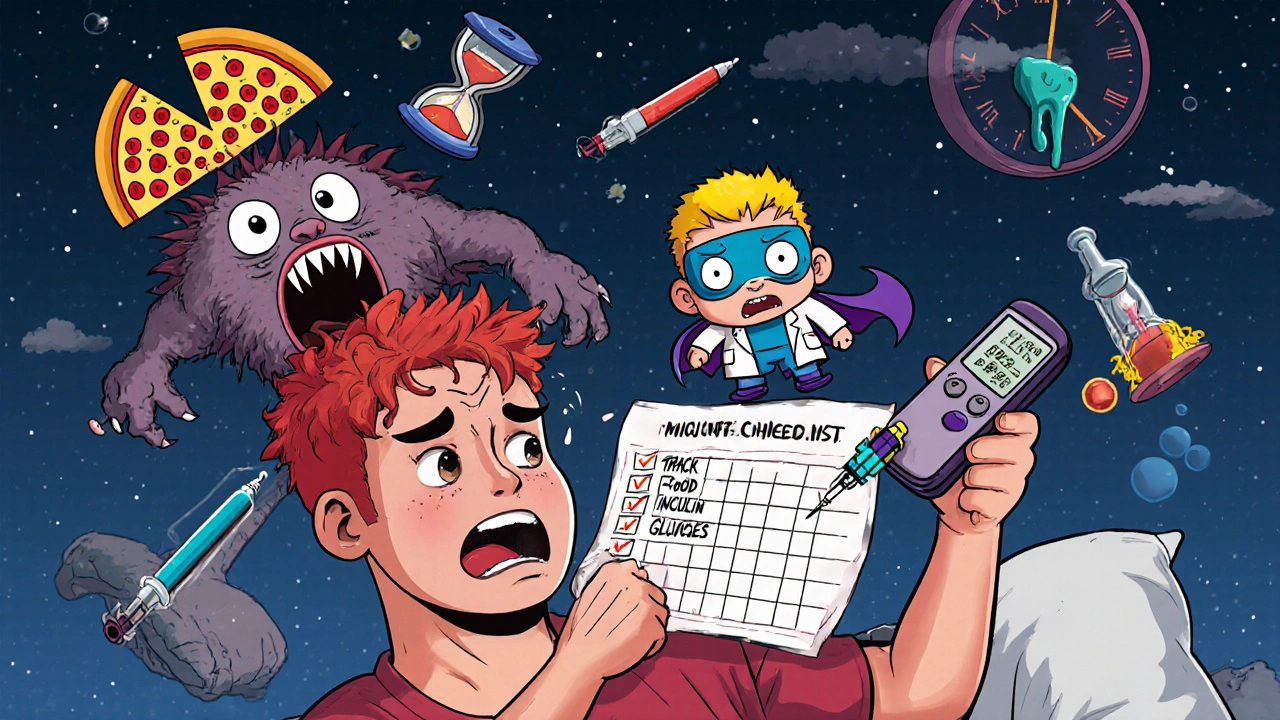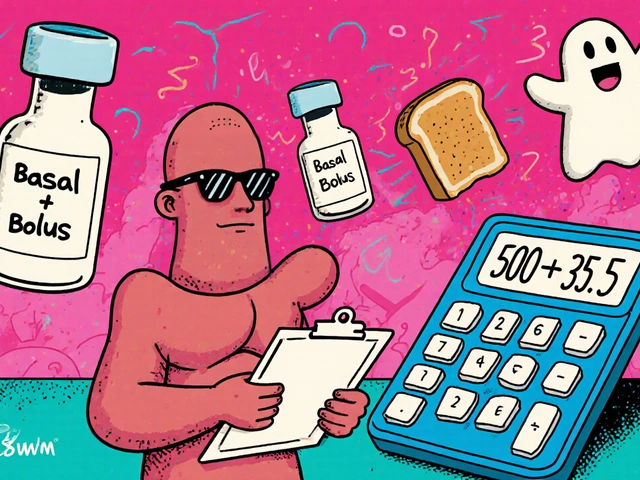Managing diabetes isn’t just about taking insulin-it’s about timing it right, matching it to what you eat, and adjusting when your body needs it. Basal-bolus insulin therapy is the most physiologic way to replace insulin, mimicking how a pancreas works naturally. It’s not the easiest approach, but for many people with type 1 diabetes-and some with type 2-it’s the most effective. If you’ve been on premixed insulin or just basal insulin and still see high spikes after meals, basal-bolus might be the next step. But getting it right takes more than a prescription. It takes understanding how to calculate doses, when to adjust them, and how to avoid dangerous lows.
What Is Basal-Bolus Insulin?
Basal-bolus insulin combines two types of insulin: long-acting (basal) and rapid-acting (bolus). Basal insulin works all day and night to keep your blood sugar steady between meals and while you sleep. Bolus insulin is taken at mealtimes to cover the carbs you eat and to fix high blood sugar. Together, they give you control over both your background glucose and your meal spikes.
This isn’t new. The Diabetes Control and Complications Trial (DCCT) in 1993 proved that tight control with multiple daily injections cuts the risk of eye, kidney, and nerve damage by up to 76%. Today, the American Diabetes Association (ADA) still calls it the gold standard for type 1 diabetes. It’s also used in type 2 diabetes when pills and basal insulin alone aren’t enough to reach your HbA1c goal.
Unlike premixed insulin, which comes in fixed ratios and forces you to eat at set times, basal-bolus gives you freedom. You can skip a meal, eat a big dinner, or work out after lunch-and still adjust your insulin to match. But that freedom comes with responsibility. You need to count carbs, check your blood sugar often, and learn how to tweak your doses.
How to Calculate Your Total Daily Insulin Dose
Every basal-bolus plan starts with your total daily insulin requirement (TDIR). This is the total amount of insulin you’ll need in a day. The ADA recommends starting with 0.5 units per kilogram of body weight. That’s the average for most adults with type 1 diabetes who aren’t overweight or insulin resistant.
Here’s a simple way to figure it out:
- Weight in kilograms × 0.5 = TDIR
- Or, if you use pounds: Weight in pounds ÷ 4 = TDIR
For example, a person weighing 70 kg (154 lbs) would start with:
- 70 × 0.5 = 35 units per day
- Or 154 ÷ 4 = 38.5 units per day (round to 38 or 40)
Some people need more-up to 1.0 unit/kg-if they’re overweight, stressed, sick, or taking steroids. Others need less-down to 0.4 unit/kg-if they’re very active or sensitive to insulin. Your doctor will adjust this based on your blood sugar patterns.
Splitting Your Dose: Basal vs. Bolus
Once you know your TDIR, you split it into basal and bolus. The standard is a 50/50 split. That means half your daily insulin is long-acting, and half is rapid-acting for meals and corrections.
Using the 35-unit example:
- Basal insulin: 17.5 units per day (round to 18)
- Bolus insulin: 17.5 units per day (split among meals)
Your basal insulin is usually taken once a day-either in the morning or at bedtime-depending on the type. Long-acting insulins like glargine (Lantus), detemir (Levemir), or degludec (Tresiba) last 20 to 42 hours. The goal is to keep your fasting blood sugar between 80 and 130 mg/dL. If it’s consistently higher, you increase your basal dose by 1 to 2 units every 2 to 4 days.
For bolus insulin, you start with 4 units per day total or 10% of your basal dose. Then you divide it across meals. Most people take the biggest bolus at dinner, the second largest at lunch, and the smallest at breakfast, because insulin resistance is usually higher in the morning.
Carbohydrate Coverage: How Much Insulin for Your Food?
Every gram of carbohydrate raises your blood sugar. You need to know how much insulin covers each gram. That’s your insulin-to-carb ratio (ICR).
The formula is simple: 500 ÷ TDIR = grams of carbs covered by 1 unit of insulin.
For a 35-unit TDIR:
- 500 ÷ 35 = 14.3
- So, 1 unit of insulin covers about 14 grams of carbs
If you eat 60 grams of carbs at lunch, you’d take 60 ÷ 14 = 4.3 units. Round to 4 or 4.5 based on your preference and how your body responds.
But this is just a starting point. Some people need 1 unit per 10 grams. Others need 1 unit per 20. It depends on your sensitivity. Track your blood sugar 2 hours after meals for a week. If it’s consistently above 180 mg/dL, you need more insulin per gram. If it’s dropping below 100, you need less.

Correction Doses: Fixing High Blood Sugar
Even with perfect carb counting, your blood sugar can spike from stress, illness, or missed doses. That’s where correction doses come in.
The formula is: 1700 ÷ TDIR = mg/dL drop per 1 unit of insulin. This is called your insulin sensitivity factor (ISF).
For a 35-unit TDIR:
- 1700 ÷ 35 = 48.6
- So, 1 unit lowers your blood sugar by about 50 mg/dL
If your pre-meal sugar is 200 mg/dL and your target is 120, you’re 80 mg/dL high. You’d take 80 ÷ 50 = 1.6 units. Round to 1.5 or 2.
Some providers use a simpler rule: 1 unit per 25 mg/dL above target. That’s less precise but easier for beginners. Use the 1700 rule if you’re comfortable with numbers. Use the 25 mg/dL rule if you’re just starting.
When Basal-Bolus Works Best-and When It Doesn’t
Basal-bolus therapy shines in people who:
- Have type 1 diabetes
- Struggle with high post-meal sugars
- Have unpredictable schedules
- Want to eat what they want, when they want
- Are motivated to learn and track
But it’s not for everyone. It fails when:
- You have trouble counting carbs accurately
- You’re afraid of low blood sugar and avoid taking insulin
- You have cognitive issues or limited dexterity
- You can’t check your blood sugar 4-6 times a day
- You’re older than 65 and on a fixed income
A 2022 survey found that 42% of new users needed extra education beyond their initial training. And 68% said dose calculations were confusing. If you’re overwhelmed, ask for help from a certified diabetes care and education specialist (CDCES). Studies show patients who work with CDCES have 37% better outcomes.
Real People, Real Results
On the American Diabetes Association’s community forum, one user wrote: “I went from an A1c of 8.5% to 6.7% in six months after switching to basal-bolus. But I cried during my third week of carb counting.” Another Reddit user said: “I’ve been on it for two years. I still second-guess every bolus.”
That’s normal. The learning curve takes 4 to 12 weeks. You’ll make mistakes. You’ll have highs and lows. But the payoff is worth it. The T1D Exchange Registry found that 78% of users felt their overall control improved. And 62% said they finally felt free to eat out or travel without stress.
One man in Manchester, 58, switched from twice-daily premixed insulin to basal-bolus after his A1c stayed above 8%. He started with 40 units total: 20 basal, 20 bolus. He tracked everything in an app. After three months, his A1c dropped to 6.8%. He now eats pizza on Fridays without fear. “It’s not magic,” he said. “It’s math. And I got better at math.”

What’s New in Basal-Bolus Therapy
Technology is changing how people use basal-bolus. Hybrid closed-loop systems-like Tandem’s Control-IQ or Medtronic’s 780G-automatically adjust basal insulin based on continuous glucose monitor (CGM) data. You still bolus for meals, but your pump handles the background. In 2023, users gained over 2 hours per day in target range (70-180 mg/dL) compared to standard basal-bolus.
Novo Nordisk’s new insulin icodec, expected in 2025, lasts up to 40 hours. That means you might only need to inject basal insulin every other day. It could simplify things for people who struggle with daily injections.
But the core principles haven’t changed. You still need to count carbs. You still need to correct highs. You still need to understand how your body responds. Technology helps-but it doesn’t replace knowledge.
Getting Started: Your First Steps
If you’re considering basal-bolus, here’s how to begin:
- Get your weight in kilograms.
- Calculate your TDIR: weight × 0.5.
- Split it 50/50: basal = half, bolus = half.
- Start basal insulin at 10 units or 0.1-0.2 units/kg, whichever is higher.
- Start bolus at 4 units total per day (or 10% of basal).
- Use 500 ÷ TDIR for carb ratio and 1700 ÷ TDIR for correction.
- Check your blood sugar before meals, 2 hours after, and at bedtime.
- Record everything: food, insulin, glucose, activity.
- Meet with a CDCES for at least 2 sessions in the first month.
Don’t try to perfect it in a week. It takes time. Your first month is about learning patterns, not hitting perfect numbers. A1c goals come later. The first win is consistency.
Common Mistakes to Avoid
- Skipping carb counting because it’s “too hard.” Without it, bolus doses are guesswork.
- Overcorrecting highs. Taking too much insulin can cause dangerous lows.
- Not adjusting basal insulin. If your fasting sugar is high for 3 days, increase your basal dose.
- Ignoring exercise. Physical activity lowers blood sugar. Reduce your bolus or eat extra carbs before activity.
- Waiting too long to ask for help. If you’re confused, call your diabetes educator. Don’t wait until you’re in a crisis.
The goal isn’t perfection. It’s progress. Even a 1% drop in A1c cuts your risk of complications by 40%. That’s not just a number-it’s years of life, better health, and freedom.
Is basal-bolus insulin only for type 1 diabetes?
No. While it’s the standard for type 1 diabetes, it’s also recommended for type 2 diabetes when oral medications and basal insulin alone don’t get your HbA1c below 7%. People with type 2 who have high post-meal spikes, are insulin deficient, or need tight control for pregnancy or surgery often benefit from basal-bolus therapy.
Can I use basal-bolus without a pump?
Yes. Most people on basal-bolus use multiple daily injections (MDI)-not pumps. You inject basal insulin once or twice a day with a pen or syringe, and bolus insulin before each meal. Pumps are an option, but they’re not required. Many people manage perfectly well with pens and a glucose meter.
How long does it take to get good at basal-bolus?
Most people feel comfortable after 4 to 8 weeks with consistent practice. Full mastery-knowing how to adjust for illness, stress, or exercise-can take 3 to 6 months. The key is tracking your numbers and making small, smart changes. You don’t need to be perfect. You need to be consistent.
What if I forget to bolus before a meal?
If you realize within 15-20 minutes of eating, take your full bolus. If it’s been longer, check your blood sugar. If it’s high, take a correction dose-but only 50-75% of what you’d normally use, since some insulin is still working from your last dose. Never take a full correction after a meal if you’ve already eaten a lot; you risk a low later.
Why do I get low blood sugar at night?
Nighttime lows often mean your basal insulin is too high. Check your fasting glucose for 3-5 nights. If it’s consistently below 80 mg/dL, reduce your basal dose by 1-2 units. Also, review your dinner bolus: did you take too much insulin for a low-carb meal? Or did you exercise in the evening? Adjusting your basal or reducing your evening bolus can help.
Can I switch back to premixed insulin if basal-bolus is too hard?
Yes. If basal-bolus causes too much stress, anxiety, or frequent lows, it’s okay to go back. Your health comes first. Some people do better with premixed insulin, especially older adults or those with cognitive challenges. The goal isn’t to use the most advanced therapy-it’s to use the one that keeps you safe and in range long-term.
Final Thoughts
Basal-bolus insulin isn’t a cure. It’s a tool. A powerful one. But like any tool, it only works if you know how to use it. The math is straightforward. The learning is hard. The rewards are real. Better sleep. Fewer highs. More freedom. Less fear.
You don’t have to be perfect. You just have to be willing to try. And if you get stuck? Reach out. You’re not alone. Thousands of people are right there with you-calculating, adjusting, learning, and surviving. One dose at a time.


They say basal-bolus is the gold standard but have you seen the price of test strips? I’m on Medicare and I’m literally choosing between insulin and groceries. This whole ‘freedom’ thing is just a luxury ad for people who don’t have to work two jobs.
From a clinical endocrinology standpoint, the 50/50 split assumption is fundamentally flawed in insulin-resistant phenotypes. The 500 and 1700 rules are population-derived heuristics with poor individual predictive validity-especially in South Asian populations where visceral adiposity drives disproportionate hepatic insulin resistance. You need dynamic C-peptide profiling and HOMA-IR stratification to avoid iatrogenic hypoglycemia. Most clinicians still treat this like a one-size-fits-all algorithm.
Man, I’ve been here. First week on basal-bolus I cried over carb counts too. But you know what? I started writing down everything-even the bad numbers. Didn’t fix it overnight, but I stopped fighting my body and started listening. You don’t need to be perfect, just persistent. And if you’re stuck? Find a diabetes buddy. Someone who gets it. You’re not alone in this mess.
Let’s be real-this article reads like a pharmaceutical marketing pamphlet. The ‘76% reduction in complications’ statistic is from the DCCT, which used outdated insulin and no CGMs. Modern T1D patients on closed-loop systems have 85% time-in-range. This ‘basal-bolus is gold standard’ nonsense ignores technological progress. You’re basically being sold a 1993 solution with a 2024 price tag.
WHY DOES NO ONE TALK ABOUT THE MENTAL TOXICITY OF THIS?! 😭 I’m 27, I check my sugar 8x a day, I count carbs like a math ninja, and I still get yelled at by my own body. I hate that my pancreas is dead and I have to be a robot. I miss just eating a donut without calculating insulin like I’m launching a rocket. 😫
People who say basal-bolus is ‘too hard’ are just lazy. If you can’t count carbs or check your glucose, you shouldn’t be on insulin. This isn’t a hobby-it’s survival. If you can’t handle the responsibility, maybe you shouldn’t be alive to need it.
LOL so you’re telling me I need to do MATH before pizza? 🍕 I thought diabetes was about ‘eating healthy’ and ‘avoiding sugar’-not becoming a human calculator. I’m out. 🙃
I’ve been on basal-bolus for 4 years. The first month was hell. But now? I eat tacos at midnight and still sleep through the night. It’s not magic-it’s patience. And honestly? The freedom to eat when I want? Worth every panic low and tearful spreadsheet.
There’s so much pressure to be perfect with this stuff, but here’s the truth: progress > perfection. A1c dropping from 8.5 to 7.5? That’s a win. Not having a DKA hospital visit? That’s a win. Feeling like you can travel without panic? That’s a win. You don’t need flawless numbers-you need consistency, compassion, and a good support system. You’re doing better than you think.
Wow, you people are so naive. This isn’t medicine-it’s a corporate experiment. Big Pharma wants you dependent on strips, pens, and apps. They don’t want you cured. They want you calculating, checking, and buying. Wake up. The real solution is a low-carb keto diet and fasting. But they won’t tell you that because it doesn’t sell insulin.
India has 77 million diabetics. You think this 500/1700 rule works for our body types? We’re smaller, more insulin resistant, and eat more rice. Your ‘standard’ is a Western fantasy. We need Indian-specific guidelines-not this colonial math.
Apologies for the typo in my last comment-‘basal’ was misspelled as ‘bassal.’ That said, the mathematical framework presented herein is statistically sound, albeit underappreciated in clinical practice due to systemic underfunding of diabetes education. The 500 and 1700 rules remain empirically valid within ±12% variance in most adult populations.
They’re hiding something. Why do all the studies say basal-bolus is best but the CDC says only 12% of Type 1s use it? It’s not because it’s hard-it’s because they don’t want you to know about the alternative. I found a video on YouTube from a guy who reversed his diabetes with apple cider vinegar and infrared saunas. He’s been off insulin for 3 years. Why isn’t this in the ADA guidelines? 🤔